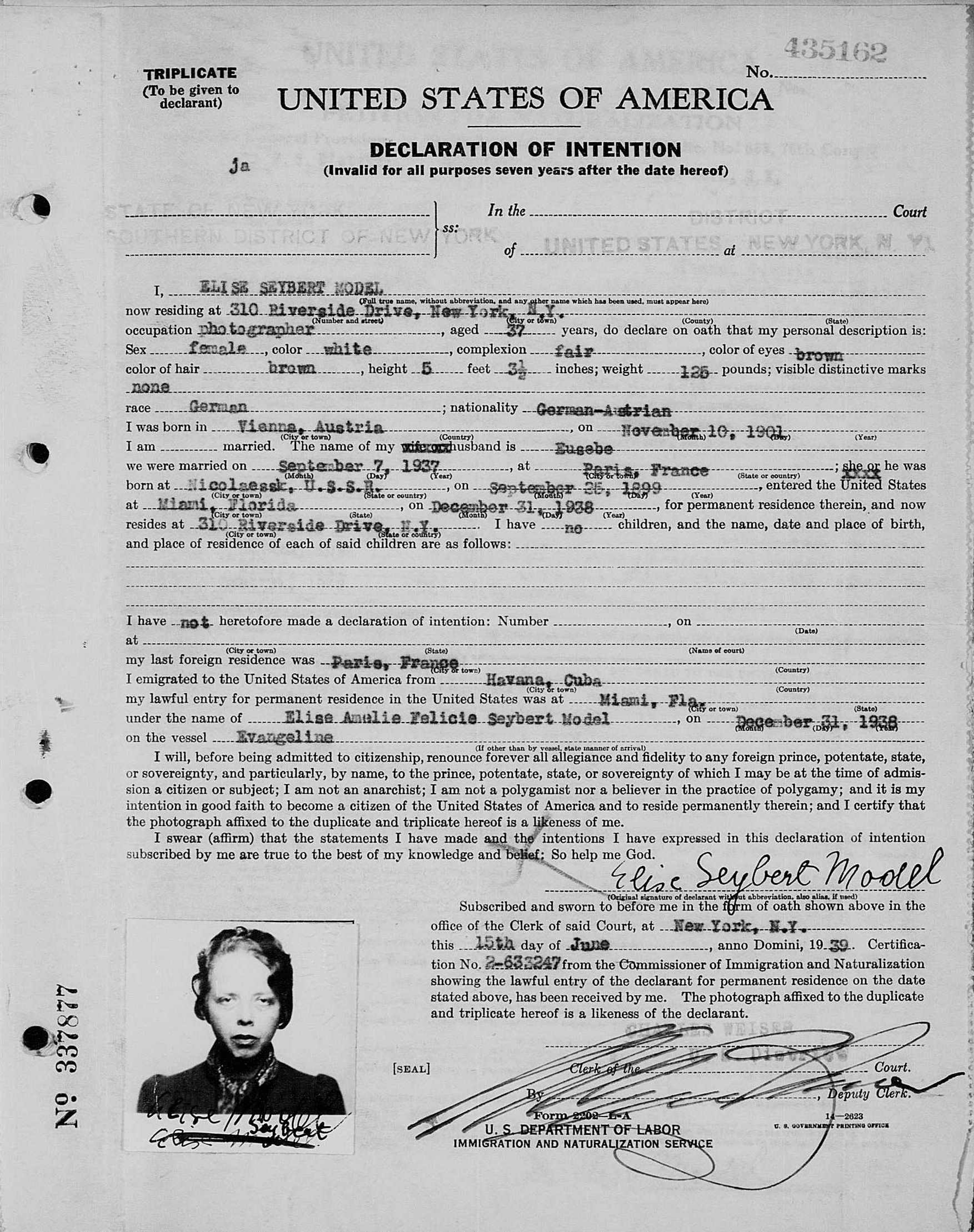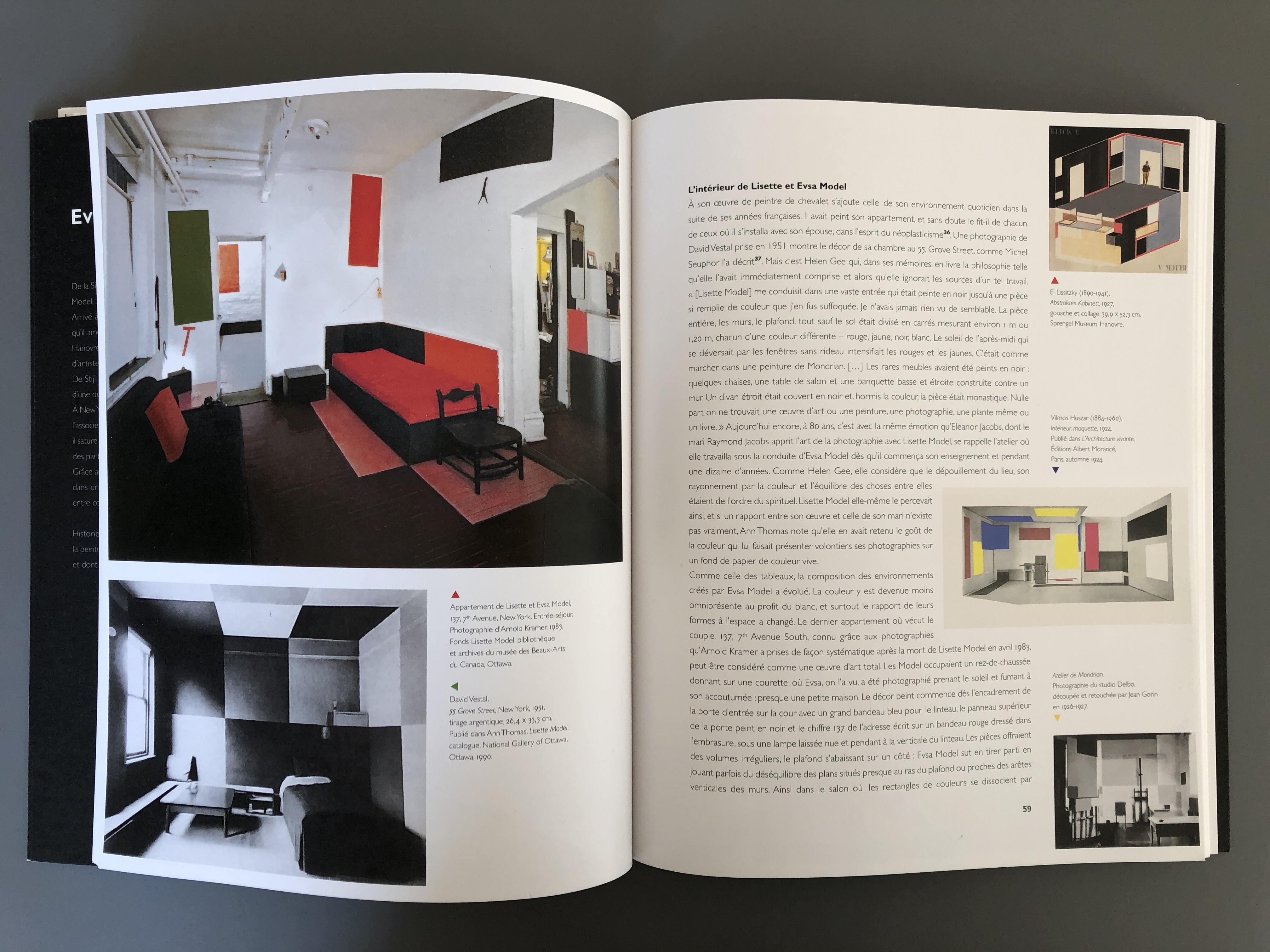Archive
Lisette Model
- Lisette
- Model
Élise Amélie Félicie Stern, Elise Seybert Model
- 10-11-1901
- Vienna (AT)
- 30-03-1983
- New York City (US)
- Photographer
Lisette Model was an Austrian-born photographer who lived in New York with her husband Evsa Model after emigrating from France. Her street photographs capturing the curiosities of everyday life quickly caught the interest of museums and magazines.
Word Count: 37

Hermann Landshoff, Die Fotografin Lisette Model, New York 1948 (© bpk / Münchner Stadtmuseum, Sammlung Fotografie / Archiv Landshoff). 
Lisette Model at New School by Joe Covello, 1960s, New School for Research Archive, Photograph Collection, NS.04.01.01:16 (© The New School Archives and Special Collection, The New School, New York, NY). 
Announcement of "The Small Camera In Photography Today" course by Lisette Model. New School Bulletin. Art Classes, vol. 9, no. 2, September 1951, front cover and p. 34 (© New School course catalog collection, NS-05-01-01. The New School Archives). 
Lisette Model's naturalisation papers. New York, Southern District, U.S District Court Naturalization Records, 1824–1946. Petitions for naturalization and petition evidence 1944 box 942, no 490001-490300 > image 702 of 1406; citing NARA microfilm publication M1972 (Family Research. © Southern District of New York Petitions for Naturalization, 1897–1944. Records of District Courts of the United States, 1685–2009, RG 21. National Archives at New York). 
Page with photos of the apartments at 55 Grove Street and 137 7th Avenue, published in Le Pommeré, 2010, pp. 58–59 (Photo: Helene Roth). Die Kamera ist grausam. The camera is cruel. Meisterwerke von Lisette Model, Diane Arbus und Nan Goldin, edited by Daniel Jelitzka and Gerald A. Matt, exh. cat. FLATZ Museum, Dornbirn, 2018.
Displaced Visions. Émigré Photographers of the 20th Century, edited by Nissan N. Perez, exh. cat. The Israel Museum, Jerusalem, 2013.
Dogramaci, Burcu, and Helene Roth. “Fotografie als Mittler im Exil: Fotojournalismus bei Picture Post in London und Fototheorie und -praxis an der New School for Social Research in New York.” Vermittler*innen zwischen den Kulturen, special issue of Zeitschrift für Museum und Bildung, vol. 86–87, 2019, pp. 13–44.
Dogramaci, Burcu, and Roth Helene Roth, editors. Nomadic Camera. Fotografie, Exil und Migration, special issue of Fotogeschichte. Beiträge zur Geschichte und Ästhetik der Fotografie, vol. 39, no. 151, 2019.
Gilbert, George. The Illustrated Worldwide Who’s Who of Jews in Photography. G. Gilbert, 1996.
Krohn, Claus-Dieter, et al., editors. Exilforschung. Ein internationales Jahrbuch, vol. 21: Film und Fotografie. edition text + kritik, 2003.
Le Pommeré, Marianne. Evsa Model. Peintre Américain. Norma Éditions, 2010.
Lisette Model. Photographien 1933 - 1983, edited by Reinhold Mißelbeck and Ann Thomas, exh. cat. Museum Ludwig Köln, Cologne, 1992.
Lisette Model. Fotografien 1934–1960, edited by Monika Faber and Gerald Matt, exh. cat. Kunsthalle Wien, Vienna, 2000.
Lisette Model, edited by Sam Stourdzé and Ann Thomas, exh. cat. Galerie Baudoin Lebon, Paris, 2002.
Lisette Model, edited by Christina Zelich, exh. cat. Fundación Mapfre, Madrid, 2009.
Lisette Model. A Performance in Photography, edited by George Steeves, exh. cat. Mount Saint Vincent University Art Gallery, Halifax, 2011.
Lisette Model. Street Life, edited by Monica Poggi, exh. cat. CAMERA - Centro Italiano per la Fotografia, Turin, 2021.
McCausland, Elizabeth. "Feet." Minicam Photography, 5, January 1941, pp. 14–17.
Model, Lisette. „“Pictures as Art. Instructor Defines Creative Photography As Scientific Eye That Captures Life.” The New York Times, 9, December, 1951, p. 143.
Modern Look. Photography and the American Magazine, edited by Mason Klein, exh. cat. Jewish Museum, New York, 2020.
New York. Capital of Photography, edited by Max Kozloff, exh. cat. Jewish Museum, New York, 2002.
New York Photography 1890–1950. Von Stieglitz bis Man Ray, edited by Ortrud Westheider and Michael Philipp, exh. cat Bucerius Kunst Forum, Hamburg, 2012.
Reframing America: Alexander Alland, Otto Hagel & Hansel Mieth, John Gutmann, Lisette Model, Marion Palfi, Robert Frank, edited by Andrei Codrescu and Terence Pitts, exh. cat. Center for Creative Photography, Tucson, 1995.
Rosenblum, Naomi. A History of Women Photographers. Abbeville Press, 1994.
Roth, Helene. “First Pictures: New York through the lens of emigrated European photographers in the 1930s and 1940s.” Contact Zones: Photography, Migration and Cultural Encounters in the United States, edited by Justin Carville and Sigrid Lien, Leuven University Press, 2021, pp. 111–132.
Schaber, Irme. “Fotografie.” Handbuch der deutschsprachigen Emigration 1933–1945, edited by Claus-Dieter Krohn and Patrick von zur Mühlen, WBG, 1998, pp. 970–983.
Schaber, Irme. “‘Die Kamera ist ein Instrument der Entdeckung…ʼ. Die Großstadtfotografie der fotografischen Emigration in der NS-Zeit in Paris, London und New York.” Exilforschung. Ein internationales Jahrbuch, vol. 20: Metropolen des Exils, edited by Claus-Dieter Krohn et al., edition text + kritik, 2002, pp. 53–73.
Sussman, Elisabeth. Lisette Model. Phaidon, 2001.
Übersee. Flucht und Emigration österreichischer Fotografen 1920–1940, edited by Anna Auer, exh. cat. Kunsthalle Wien, Vienna, 1997.
Klaus Honnef and Frank Weyers. Und sie haben Deutschland verlassen … müssen. Fotografen und ihre Bilder 1928–1997, exh. cat. Rheinisches Landesmuseum Bonn, Bonn, 1997.
Werneburg, Brigitte. “LIFE: Leben in der Emigration. Deutsche Fotojournalisten in Amerika.” (unpublished manuscript, 1991). werneburg.nikha.org. Accessed 15 February 2021.
Word Count: 581
Paris, France (1926–1938); New York City, US (1938–1983).
310 Riverside Drive, Bloomingdale, New York City (residence, 1938–1943); 55 Grove Street, Greenwich Village, New York City(residence, 1943–1958); 137 7th Avenue, Greenwich Village, New York City (residence, 1958–1983).
- New York
- Helene Roth. "Lisette Model." METROMOD Archive, 2021, https://archive.metromod.net/viewer.p/69/2948/object/5138-8103251, last modified: 27-04-2022.
-
Walter SandersPhotographerNew York
Walter Sanders was a German émigré photographer. In 1938 he arrived in New York, where he worked from 1939 until the end of his life for the Black Star agency and, from 1944, for Life magazine.
Word Count: 33
Josef BreitenbachPhotographerNew YorkOn arriving in New York in 1941, the German photographer Josef Breitenbach tried to restart as a portrait, street and experimental photographer, as well as a teacher of photo-history and techniques.
Word Count: 30
Andreas FeiningerPhotographerWriterEditorNew YorkAndreas Feininger, was a German émigré photographer who arrived in New York with his wife Wysse Feininger in 1939. He started a lifelong career exploring the city's streets, working as a photojournalist and writing a large number of photography manuals.
Word Count: 39
Ruth BernhardPhotographerNew YorkRuth Bernhard was a German émigré photographer who lived in New York from the 1920s to the 1940s. Beside her series on female nudes, her place in the photography network, as well as in the New York queer scene, is unknown and understudied.
Word Count: 43
Alexey BrodovitchPhotographerArt DirectorGraphic DesignerNew YorkAlexey Brodovitch was a Belarus-born émigré graphic artist, art director and photographer who, from 1933, worked in New York for Harper’s Bazaar magazine and at the New School for Social Research.
Word Count: 31
Rolf TietgensPhotographerEditorWriterNew YorkRolf Tietgens was a German émigré photographer who arrived in New York in 1938. Although, in the course of his photographic career, his artistic and surrealist images were published and shown at exhibitions, his work, today, is very little known.
Word Count: 39
Marion PalfiPhotographerNew YorkMarion Palfi was a German émigré photographer who lived in New York from the 1940s to the 1960s. Her photographic engagement in social and political topics made her name for her use of the camera to draw attention to social injustices.
Word Count: 41
Tim GidalPhotographerPublisherArt HistorianNew YorkTim Gidal was a German-Jewish photographer, publisher and art historian emigrating in 1948 emigrated to New York. Besides his teaching career, he worked as a photojournalist and, along with his wife Sonia Gidal, published youth books.
Word Count: 35
Ruth JacobiPhotographerNew YorkRuth Jacobi was a German-speaking, Polish-born photographer who emigrated in 1935 to New York, where she opened a studio together with her sister Lotte Jacobi. She later had her own portrait studio.
Word Count: 31
Fritz HenlePhotographerNew YorkFritz Henle was a German Jewish photographer who emigrated in 1936 to New York, where he worked as a photojournalist for various magazines. He also published several photobooks of his travels throughout North America and Asia.
Word Count: 35
Carola GregorPhotographerSculptorNew YorkThe German émigré photographer Carola Gregor was an animal and child photographer and published some of her work in magazines and books. Today her work and life are almost forgotten.
Word Count: 30
Rudy BurckhardtPhotographerFilmmakerPainterNew YorkRudy Burckhardt was a Swiss-born photographer, filmmaker and painter who emigrated from Basle to New York City in 1935. He was well networked within the emerging Abstract Expressionist art scene of 1940s' and 50s'.
Word Count: 33
T. Lux FeiningerPhotographerPainterNew YorkLux T. Feininger was a German-American émigré photographer and painter and the brother of the photographer Andreas Feininger, arriving in 1936 in New York. Although he started taking photographs during the 1920s in Germany, Feininger is better known for his career as a painter and his photographic work is largely unacknowledged.
Word Count: 50
Trude FleischmannPhotographerNew YorkTrude Fleischmann was an Austrian-Jewish portrait and dance photographer who emigrated in 1939 to New York, where she opened a studio in Midtown Manhattan with the photographer Frank Elmer.
Word Count: 28
New School for Social ResearchAcademy/Art SchoolPhoto SchoolUniversity / Higher Education Institute / Research InstituteNew YorkDuring the 1940s and 1950s emigrated graphic designers and photographers, along with artists and intellectuals, were given the opportunity to held lectures and workshops at the New School for Social Research.
Word Count: 31
Beggar BarBarNew YorkBeggar Bar was an artists bar and cabaret which was founded in 1941 by the German actress and dancer Valeska Gert (1892–1978).
Word Count: 20
Service Photo Suppliers Inc.Photo SupplierNew YorkService Photo Suppliers was a photo supplier distributing a wide variety of photo equipment and opened by the German émigré Hans Salomon (1909–?) in 1945.
Word Count: 23
SpiratonePhoto SupplierNew YorkSpiratone was a photo company and photo supplier founded in 1941 by the Austrian émigré family Hans (1888–1944) and Paula Spira (?–?) and their son Fred Spira (1924–2007).
Word Count: 24
Hermann LandshoffPhotographerNew YorkBesides outdoor fashion shots, Hermann Landshoff was a portrait and street photographer. During his time in New York, he captured the cultural, artistic and intellectual émigré scene as well as his photographer colleagues.
Word Count: 33
László Moholy-NagyPhotographerGraphic DesignerPainterSculptorLondonLászló Moholy-Nagy emigrated to London in 1935, where he worked in close contact with the local avantgarde and was commissioned for window display decoration, photo books, advertising and film work.
Word Count: 30
Kurt SafranskiPicture AgentFounding MemberTeacherCartoonistPublisherIllustratorNew YorkKurt Safranski was one of the founding members of the Black Star photo agency, a teacher at the New School for Social Research and the author of photojournalistic articles and books.
Word Count: 31
Werner WolffPhotographerNew YorkWerner Wolff was forced to leave Germany in 1936 due to his Jewish background and emigrated via Hamburg to New York, where he could follow his career as photographer and photojournalist.
Word Count: 30
Erika StonePhotographerNew YorkErika Stone is a German émigré, who moved to New York with her parents and sister in December 1936, at the age of 12. She went on to carve out a career as photographer.
Word Count: 32
Fred SteinPhotographerLawyerNew YorkAlways accompanied by his camera, the German émigré photographer Fred Stein discovered New York City during the 1940s and 1950s. His pictures provide an human and multifaceted view of the metropolis.
Word Count: 31
Charles LeirensPhotographerMusicianMusicologistNew YorkCharles Leirens was a Belgian-born musician and photographer who emigrated to New York in 1941. While publishing two books on Belgian music, he also gave courses in musicology and photography at the New School for Social Research.
Word Count: 36
Lotte JacobiPhotographerNew YorkIn October 1935 the German émigré photographer Lotte Jacobi, together with her sister Ruth Jacobi, opened a photo studio on 57th Street. The two sisters had to leave their parents' photo studio in Berlin in the 1930s and emigrated to New York.
Word Count: 41
Lilly JossPhotographerNew YorkLilly Joss was an émigré freelance photographer in New York. She worked for the Black Star photo agency and magazines and was also a portrait and theatre photographer.
Word Count: 28